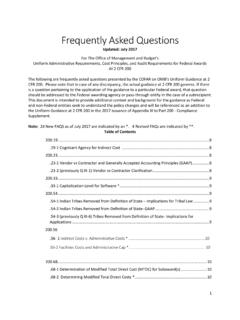Transcription of Frequently Asked Questions for Vendor Subscription Agreements
1 Frequently Asked Questions for Vendor Subscription Agreements1. How do changes in media costs affect the purchase commitment?Changes in media costs do not affect the VSA purchase commitment. Media costs will increase and/or decrease over time based on the overall supply and demand in the media market. The past several years represented a period of rising media prices and prices are predicted to decline in the current year. The dollars spent will simply purchase more or less media as denominated in spots or rating points.
2 Once the benchmark is set, ICON adjusts the media delivery to match the current market price. Therefore, if media prices decline by 10%, the same dollars will purchase 10% more How is the VSA interest rate determined?Based on the credit review performed by ICON s Credit Department, the interest rate is set between 10% and 13%. The Customer may be able to borrow from conventional sources at lower rates. These rates reflect the structure of the VSA obligation. The VSA obligation assumed by the Customer is unsecured and not recorded on the Customer s balance sheet.
3 This is a very desirable financial structure and one that is difficult if not impossible to duplicate. A 10% rate is used for investment-grade companies (NAIC rating of 1 or 2) and a higher rate is used for non-investment-grade companies (NAIC rating of 3 or 4).3. How is the VSA purchase obligation calculated?The purchase obligation is based on a complete review of the historical and anticipated fulfillment benchmark purchase price and terms (ICON s best estimate of the purchasing leverage available).
4 4. How does a VSA Customer account for a VSA transaction?ICON does not provide accounting advice that should be provided by the Customer s accounting department and outside auditors. The VSA is a purchase commitment that represents a take-or-pay contract. A classic take-or-pay contract is as follows: A clothing retailer orders 1,000,000 shirts per month from a factory that adds a third shift (at considerable expense) to meet the order. The factory negotiates a minimum of 12 months of production; otherwise, it would not recover costs associated with gearing up for such an order (the factory would lose money starting up the third shift if the purchase commitment turned out to be for only 1 month).
5 The parties further agree that if the clothing retailer does not make the minimum purchase, a penalty is charged the clothing retailer so the factory can cover the unamortized costs associated with the start-up of the third shift. The ICON VSA contract is a take-or-pay contract. If the minimum media purchases are not met, an unwind or guaranteed minimum payment is required. Take-or-pay contracts are purchase commitments and the minimum guaranteed payments are contingent liabilities that can become actual liabilities if the expectation of making a payment rather than meeting the purchase commitment becomes likely.
6 FAS No. 47 addresses the accounting for take-or-pay contracts and the financial-statement footnote disclosures 1/2An Omnicom CompanyVendor Subscription agreement Frequently AskedQuestions107 Elm StreetFour Stamford PlazaStamford, CT 06902P: : How is a VSA different from a Cross-Purchase agreement ?A Cross-Purchase agreement (CPA) provides for a much broader purchase obligation than a VSA. The Supplier requires the right (but not the obligation) to purchase on behalf of the Customer and the Customer is obligated to purchase from the Supplier any goods or services that the Customer purchases and the Supplier can deliver at the benchmark price.
7 This opens the purchase obligation to everything the Customer buys, creates a significant administrative burden on the Customer s purchasing process and may have several long-term negative effects on the Customer s relationships with suppliers. The insurance coverage offered to protect the Customer is extremely expensive and almost impossible to collect on any claim. The cost is in excess of 5% per annum (a typical performance bond will cost between .5% and 1% per annum). The procedures outlined in the insurance contract are so difficult for the Customer to meet that collecting any claim under the insurance contract is remote.
8 The devil is in the details of a CPA. In comparison, the VSA is a relatively simple design with easy-to-understand obligations assumed by both parties. The purchase obligation assumed by the Customer in a VSA is substantially less than in a CPA, primarily because of 2/2An Omnicom CompanyVendor Subscription agreement FrequentlyAskedQuestions107 Elm StreetFour Stamford PlazaStamford, CT 06902P.









